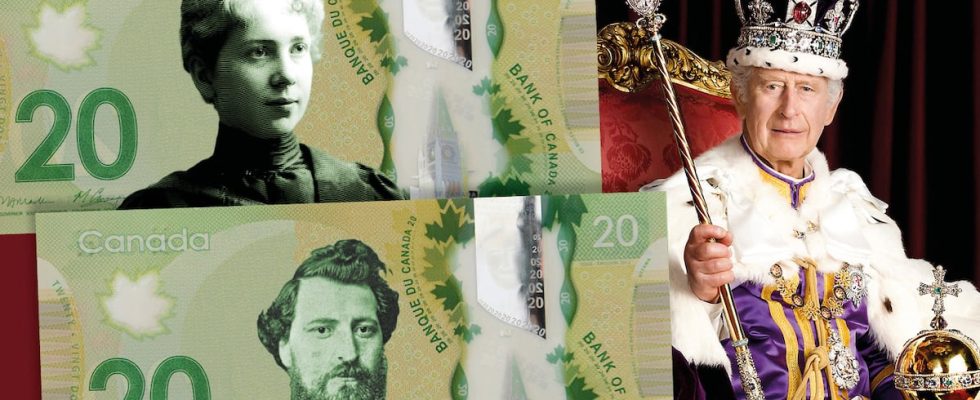OTTAWA | By keeping the portrait of the monarch on our banknotes and coins, the Trudeau government has missed a good opportunity to modernize the Canadian currency so that it is more in tune with public opinion.
• Read also: How to get rid of Justin Trudeau politically
• Read also: Anglican leader on trial for speeding
• Read also: Celebrity fashion: Looks from the Met after-party and the coronation of King Charles III
“By offering King Charles III the same visibility as Queen Elizabeth II, the elites in Ottawa are showing that they are disconnected from public opinion, that they are out of step with reality,” said jurist Patrick Taillon. from Laval University.
After months of dithering, Justin Trudeau took advantage of the coronation of Charles III on Saturday to order the Royal Canadian Mint to design coins bearing the king’s effigy.
- Listen to the interview with François Rufiange, President of the Numismatic Society of Quebec on Yasmine Abdelfadel’s show via QUB-radio :
In the same breath, the Prime Minister indicated that the portrait of Charles III would replace that of Elizabeth II on the next $20 bills to be printed by the Bank of Canada.
Justin Trudeau pointed out that the monarch has been on our banknotes since 1935 and on our coins since 1908.
AFP
Prime Minister Justin Trudeau and his wife Sophie Grégoire Trudeau at Westminster Abbey for the coronation of King Charles III and Queen Consort Camilla.
But Mr. Taillon, an expert in constitutional law, recalls that the Canadian authorities have no legal obligation to offer as much visibility to the monarchy.
“It’s not an obligation, it’s a tradition,” he said. We do what we want. We could remain a constitutional monarchy and not put the king on the notes and coins.
Anti-monarchy sentiment
Australia has also decided to remove the facies of the monarch from its 5 dollar bills which will instead be adorned with an indigenous illustration. The country, inhabited by a strong anti-monarchy movement, nevertheless retained its political system and remained a member of the Commonwealth.
AFP
‘For a Republic – Not my King’ protest in Edinburg, Scotland, on Charles III’s coronation day.
A similar movement has emerged in Canada two years ago. Although opposition to the crown was not yet as strong in English Canada as in Quebec, it was growing rapidly.
In September 2022, 77% of Canadians said they were not attached to the British monarchy, according to a Léger poll. In the process, Quebec even abolished the oath to the king as an obligation to be able to sit in the National Assembly of Quebec.
Eric Bolte / QMI Agency
Anti-monarchist protester in Montreal during the visit of Prince William and Princess Catherine in 2011.
Canadian personalities
With this in mind, in December, Bloc Québécois MP Rhéal Fortin wrote to the Minister of Finance, Chrystia Freeland, to encourage her to “replace the British royal effigies with symbols that are more representative of the citizens of Quebec and Canada”.
For example, he suggested replacing the portrait of the monarch on our tickets with that of Louis Riel, Métis leader, founder of Manitoba, known for his fight against the British. An idea supported by the vice-president of the Manitoba Metis Federation, André Carrier.
In the same vein, the Toronto Star suggested that the portrait of the monarch be replaced by that of Canadian celebrities such as singer Celine Dion, environmentalist David Suzuki, or even the country’s first black MP Lincoln Alexander.
But none of these suggestions will likely have made its way to the government, which continues to want to “show the monarchy that we remain good loyal subjects”, deplores Mr. Taillon.
Some personalities for our banknotes and coins:
- Jeanne Mance (1606-1673): Co-founder of Montreal, founder of the Hôtel-Dieu and first lay nurse in the country
- Gaspar Soiaga Kondiaronk (1649-1701): Chief of the Tionontati nation, instigator of the Treaty of the Great Peace of Montreal
- Louis Riel (1844-1885): Leader of the Métis people, leading the resistance against Canadian encroachment on Métis lands, and founder of the province of Manitoba
- Harriet Brooks (1876-1933): First Canadian nuclear physicist, world pioneer in physics
- Oscar Peterson (1925-2007): Internationally renowned Canadian jazz pianist and composer
- Terry Fox (1958-1981): Canadian athlete and research activist dedicated to treating cancer









